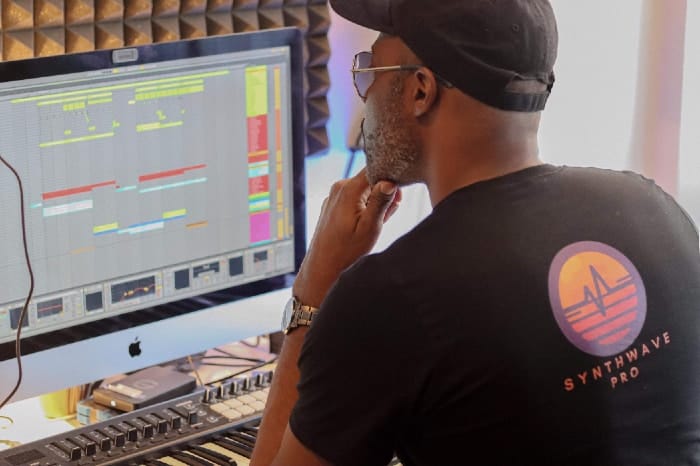Synthwave. It’s the pulsating heartbeat of the 80s, a nostalgic trip back to neon-drenched streets, chrome-clad cars, and the rise of electronic music. Want to create your own slice of retro-futuristic sound? This guide breaks down the steps to craft a synthwave track from start to finish.
Setting the Stage: Inspiration and Concept
Before diving into the technicalities, define your sonic landscape. What kind of synthwave do you want to create? Do you lean towards the dreamy soundscapes of Outrun, the darker, driving rhythms of Darksynth, or something else entirely? Think about the mood, the imagery, and the story you want to tell. Listen to your favorite synthwave artists for inspiration, but remember to find your own voice.
Building the Foundation: Drums and Bass
The rhythm section is the backbone of any track, and synthwave is no exception.
- Drums: A classic 80s drum machine sound is essential. Think crisp snares, gated reverb, and punchy kicks. Consider using samples from iconic drum machines like the Roland TR-808 or LinnDrum. Experiment with layering different drum sounds and adding subtle swing or shuffle to give your track a unique feel. Don’t overdo it – keep the drums relatively simple and repetitive, allowing the synths to breathe.
- Bass: The bassline provides the groove and anchors the harmony. A deep, resonant bass is key. Consider using a sawtooth or square wave synth bass, often layered with a sub-bass for extra depth. Experiment with glide and portamento for that classic synthwave feel. A classic technique is the arpeggiated bassline, adding movement and energy.
Crafting the Sonic Palette: Synths
Synths are the heart and soul of synthwave.
- Choosing your weapons: Software synthesizers (VSTs) are the go-to for modern synthwave production. Popular choices include emulations of classic synths like the Roland Juno-106, Yamaha DX7, and Prophet-5. Experiment with different synths to find the sounds that resonate with you.
- Layering and sound design: Don’t be afraid to layer multiple synth sounds to create rich textures. Experiment with different waveforms, filters, envelopes, and effects to sculpt your sounds. Think about using detuned oscillators for that lush, wide sound.
- Melodies and harmonies: Synthwave melodies are often simple and memorable, focusing on catchy hooks and arpeggios. Experiment with different scales and modes to create the desired mood. Don’t be afraid to use classic 80s chord progressions.

Adding the Atmosphere: Effects
Effects are crucial for creating the immersive synthwave soundscape.
- Reverb: Generous amounts of reverb are essential for creating that spacious, 80s-inspired sound. Experiment with different reverb types and settings to find the right atmosphere for your track. Gated reverb, in particular, is a classic synthwave technique.
- Delay: Delay can be used to add depth and movement to your sounds. Experiment with different delay times and feedback settings.
- Chorus: Chorus can add width and shimmer to your synths, making them sound richer and more expansive.
- Distortion and saturation: Subtle distortion or saturation can add warmth and grit to your sounds, especially the bass and drums.
Structuring the Track: Arrangement
A well-structured track will keep the listener engaged. Think about building tension and release throughout the song. A typical synthwave track structure might include:
- Intro: A gradual introduction of the main elements.
- Verse: Development of the main themes and melodies.
- Chorus: The most memorable and catchy part of the song.
- Bridge: A contrasting section that provides a break from the main themes.
- Outro: A gradual fade-out or a restatement of the intro.
Polishing the Sound: Mixing and Mastering
- Mixing: Balancing the levels of all the individual tracks is crucial for creating a clear and cohesive mix. Pay attention to the EQ and panning of each instrument to ensure that everything sits well together.
- Mastering: Mastering is the final stage of the production process, where the overall volume and dynamics of the track are optimized for playback on different systems. This process will make your track sound professional and polished.
Sharing Your Creation
Creating synthwave is a journey of experimentation and discovery. Don’t be afraid to try new things and develop your own unique sound. So, grab your synths, crank up the reverb, and dive into the neon-drenched world of synthwave!
Recent Posts
Finding time to produce music while managing a job can be challenging, but several strategies can help you balance both effectively. Prioritize Music Production Make music a priority in your...
We often imagine making music as an effortless flow of creativity—strumming guitars in sunlit rooms or producing beats late into the night with pure passion. But for many musicians, there’s a...

